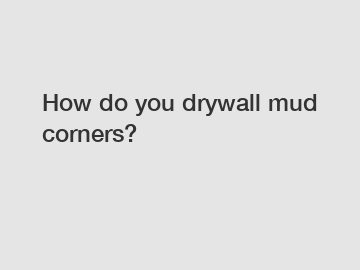Tuoxin supply professional and honest service.
How to Drywall Mud Corners.
Drywall mudding is an essential step in the process of finishing drywall and creating smooth, seamless walls. Corners, in particular, can be tricky to mud properly, but with the right tools and technique, you can achieve a professional-looking finish. In this article, we will discuss how to mud corners when working with drywall.

Preparing the Corner.
Before you can start mudding, it is important to ensure that the corner is properly prepared. This includes making sure that the drywall edges are cut cleanly and that any screws or nails are set below the surface of the drywall. Additionally, you may want to apply a corner bead to help create a straight edge and protect the corner from damage.
Applying the First Coat.
To begin mudding the corner, you will need a small drywall knife and a bucket of pre-mixed joint compound. Start by applying a thin coat of joint compound along one side of the corner, using the knife to smooth it out and remove any excess. Be sure to feather the edges of the mud to create a seamless transition between the corner and the rest of the wall.
Let the first coat dry completely before moving on to the next step. Depending on the drying time of the joint compound, this could take anywhere from a few hours to overnight. Once the first coat is dry, you can proceed with the next step.
Applying Subsequent Coats.
After the first coat has dried, you will need to apply additional coats of joint compound to build up the corner and create a smooth finish. Each subsequent coat should be wider than the previous one, with the final coat extending several inches on either side of the corner.
As you apply each coat, be sure to feather the edges and smooth out any bumps or ridges. This will help to create a seamless transition between the corner and the rest of the wall. Allow each coat to dry completely before sanding it smooth and applying the next coat.
Sanding and Finishing.
Once you have applied all of the necessary coats and the joint compound has dried, it is time to sand the corner smooth. Use a fine-grit sandpaper to gently sand down any ridges or bumps, being careful not to sand through the joint compound. You may also want to use a damp sponge to remove any dust created during the sanding process.
After sanding, you can finish the corner with a coat of primer and paint to match the rest of the wall. This will help to protect the joint compound and create a seamless, professional-looking finish.
Conclusion.
Mudding corners can be a challenging task, but with the right tools and technique, you can achieve a smooth, seamless finish that will look great for years to come. By properly preparing the corner, applying multiple coats of joint compound, and finishing with sanding and painting, you can create a professional-looking corner that blends in seamlessly with the rest of the wall.
If you have any questions or need assistance with mudding corners, feel free to contact us. We are here to help you achieve the perfect finish for your drywall project.
View Details
Are you interested in learning more about China Fiberglass Mesh Supplier? Contact us today to secure an expert consultation!



Comments
All Comments (0)